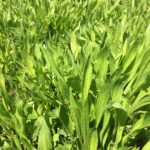Ribwort Plantain
Plantago lanceolata L.
General Description
Perennial plant with an upright habit of the Plantaginaceae family.
The leaves are located at the base of the plants and form a rosette. The blade is lanceolate and has 3 to 7 longitudinal veins. It is furnished with a few long hairs and is green in colour, but rather purplish at the base. The stem measuring 15 to 50 cm is pubescent, hollow, unbranched and grooved. The inflorescence is a cylindrical spike 2-8 cm long, formed by flowers of white color with long stamens, at the end of a long stalk. Ribwort plantain has both a taproot and a very dense fasciculate root system.
Type
Forbs (non-graminoid herbaceous plants).
Origin
Eurasia.
Longevity
3 years.
Use
Pasture.
Optimal Time of Use
Ribwort plantain has a good recovery.
Recovery After Use
Tolerates overgrazing.
Yield
Generally gives less yield than grasses.
Palatability/Nutritional Value
Ribwort plantain contains condensed tannins which reduce the risk of bloat and gastrointestinal parasitism. Rich in sugars, minerals and proteins, lanceolate plantain is very palatable.
Annual Precipitation min/max (mm)
N/A
Drought Tolerance
Good resistance to heat and drought, but performs better in cool climates.
Flooding Tolerance
Sensitive to poor drainage.
Winter Hardiness
Moderate. More resistant to winter conditions when sown in a multi-species mixture.
Soil Texture Preference
Tolerates heavy soils.
Erosion Control
Moderate.
Salinity Tolerance
Moderate.
Acidity Tolerance
Moderate. Tolerates slightly acidic or calcareous soils (pH 5.5 to 8.0).
Alkalinity Tolerance
Moderate.
Seeds per kg
440,000 seeds/kg (968,000 seeds/lb)
Suggested Mixtures
It is recommended to always sow plantain in association with at least one legume, such as white clover or red clover, and ideally in a multispecies mix also including grasses and/or other forbs. Although it does not give the highest yields, plantain is present in multi-species mixes and helps to control weeds
Ease of Establishment
Easy. It establishes quickly.
Competitiveness
Uncompetitive.
Management Considerations
Tolerates overgrazing.
Guide des plantes fourragères, CRAAQ, 2022 (in press).
NA
